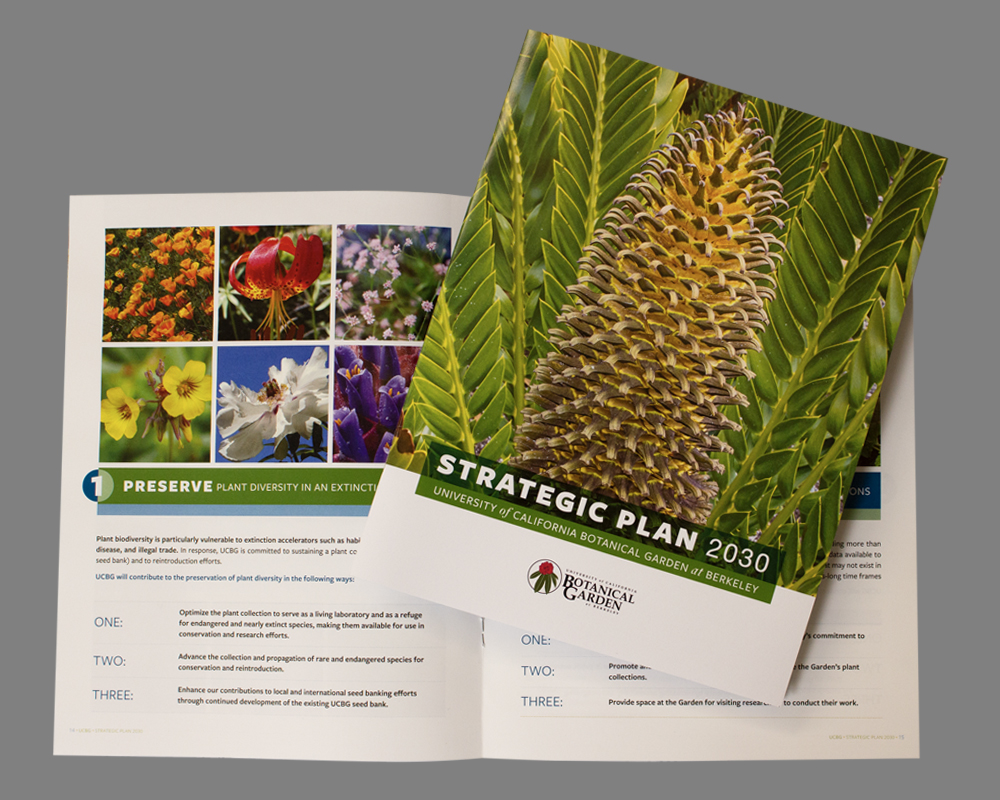
About the Garden
The University of California Botanical Garden is a 34-acre oasis in the heart of Berkeley’s urban landscape, and features one of the world’s most diverse plant collections. This unique living museum is filled with more than 10,000 kinds of plants, including many rare and endangered species. As the third-largest botanical garden in the United States in numbers of species, this world-renowned plant collection provides a vital resource—not only for international researchers, UC Berkeley faculty, students and staff, but for visitors from around the world who seek solace, inspiration, and connection with nature.
A Valuable Resource
As part of UC Berkeley—one of the world’s top public research universities—the Garden is administered by the Office of the Vice Chancellor for Research and is the only member of UC Berkeley’s Natural History Museum Consortium to be open to the public.
It’s a valuable resource for researchers, both on campus and worldwide, and plays a key role in educating students and the broader public about the importance of humanity to partner with and sustain nature. As a living laboratory, the Garden works to preserve plant biodiversity and advance our partnership with plants, which is essential for a healthy planet.
Learn more about our seed-banking and conservation efforts, and how we support botanical and other scientific research.
Mission
The Garden’s mission embodies four goals: to develop and maintain a diverse living collection of plants, to support teaching and worldwide research in plant biology, to further the conservation of plant diversity, and to promote public understanding and appreciation of plants and the natural environment.
We invite you to read our Strategic Plan 2030 to learn more about our current goals and actions that will position the Garden for expanded roles in research and education, while at the same time enhancing visitor experience.
Diversity of Plants and People
The Garden aims to mirror our diverse plant collection by cultivating an equitable and inclusive environment for our diverse community. We have a responsibility to foster a Garden where everyone can enjoy and learn from this unique place. We are committed to increasing access and growing as an adaptable and anti-racist institution.
Land Acknowledgment
We acknowledge that the Garden, as part of the UC Berkeley campus, sits on the territory of xučyun (Huichin), the ancestral and unceded land of the Chochenyo speaking Ohlone people, the successors of the sovereign Verona Band of Alameda County. Learn more.
History
Shortly after the University of California was founded in 1868, founding Dean of Agriculture Eugene W. Hilgard established a small garden of economic plants—those that are utilized for the benefit of humankind—on the site currently occupied by Moffitt Library. Today, Hilgard is considered to be the father of modern soil science.
Formally established in 1890, the University of California Botanical Garden was the first such garden in the UC system. It was founded by E. L. Greene, the first chairman of the Department of Botany, to form a living collection of the native trees, shrubs, and herbaceous plants of the State of California, with the intent to collect plants from the neighboring Pacific Coast states. Within two years the collection numbered 600 species; within a decade it grew to 1,500 species and ultimately expanded both its scope and collection to include plants from six continents—about 10,000 species in all.
The original Botanical Garden was located near Haviland Hall on the north side of campus and featured a large glass conservatory modeled after the London Crystal Palace. Between 1925 and 1928, under the guidance of Thomas Harper Goodspeed, the Garden was relocated to its current home on 34 acres in Strawberry Canyon above the main campus. Here, Goodspeed said, “the eastward moving air draft from the Golden Gate … with consequent moderating influences on summer temperature and humidity permit an association of plants, birds, and mammals not duplicated elsewhere in middle western California.”
Although not officially named curator of the Garden until 1926, Goodspeed planned the Garden with assistance from J.W. Gregg, professor in the Department of Landscape Design, and supervised its construction. Goodspeed departed from traditional botanical garden design by grouping the collections primarily by geographic regions in settings resembling their native habitats. This principle remains central to Garden policy today.
Much of the land-clearing and trail-building was accomplished by the Civilian Conservation Corps Company 751, which was assigned to the Strawberry Canyon project from October 5, 1933 to May 31, 1934. More than 200 young men from the Midwest built check dams, constructed roads, and thinned trees. This work established the context for the Garden and developed a number of features familiar to visitors today, including the stone bridge across Strawberry Creek and Mather Redwood Grove. Thomas Harper Goodspeed officially became the director of the UC Botanical Garden in 1934 and remained so until 1957. In 1974 the Garden opened to the public, becoming only one of the five natural history museums at UC Berkeley that is open to the public.
Today, the Garden contains more than 1,214 rare and endangered species in its collections. We welcome an average of 100,000 visitors a year and have a robust membership program. Yearly, more than 5,000 people attend our in-person programs, while 1,400+ tune in to our on-line programs. From local public schools, 500+ children annually attend free educational tours, and thousands of adults and children benefit from our educational docent-led tours.
We look forward to welcoming you to the Garden as well!
Banner: Puya alpestris ssp. zoellneri
